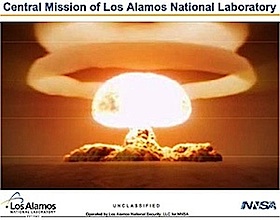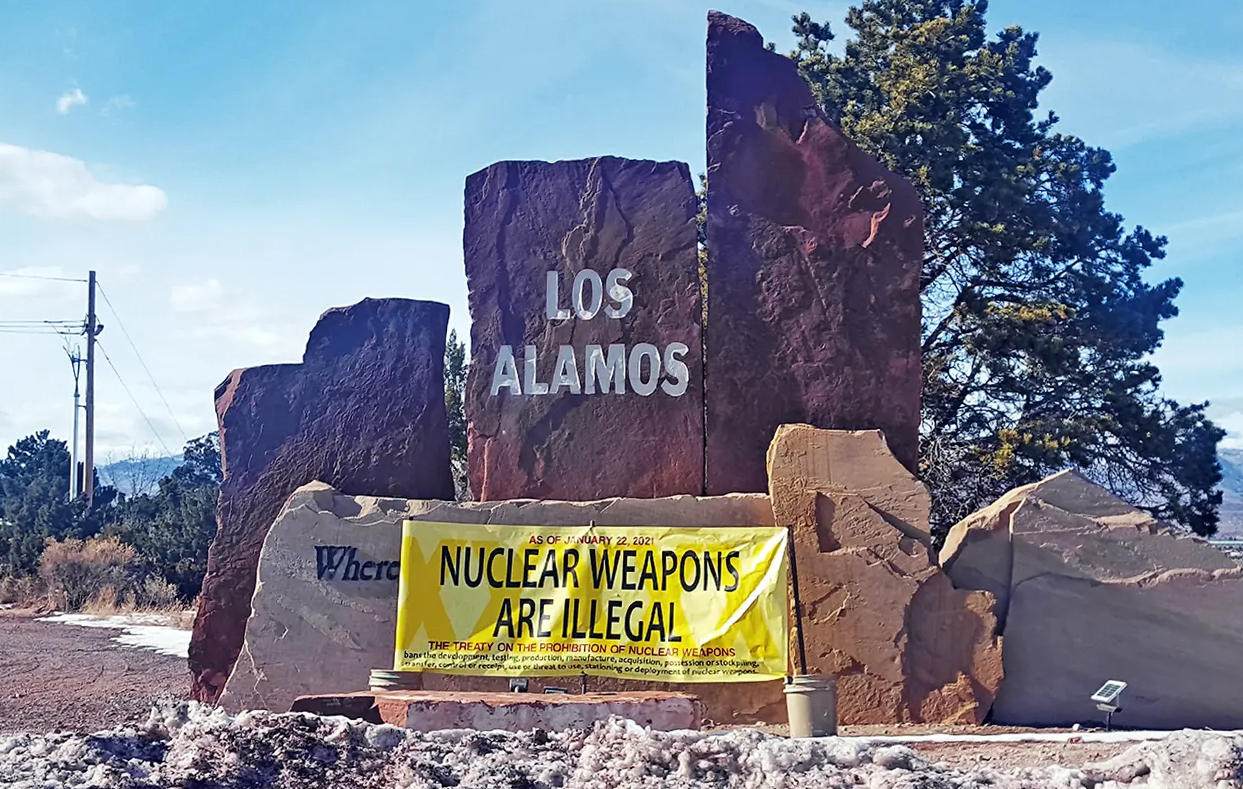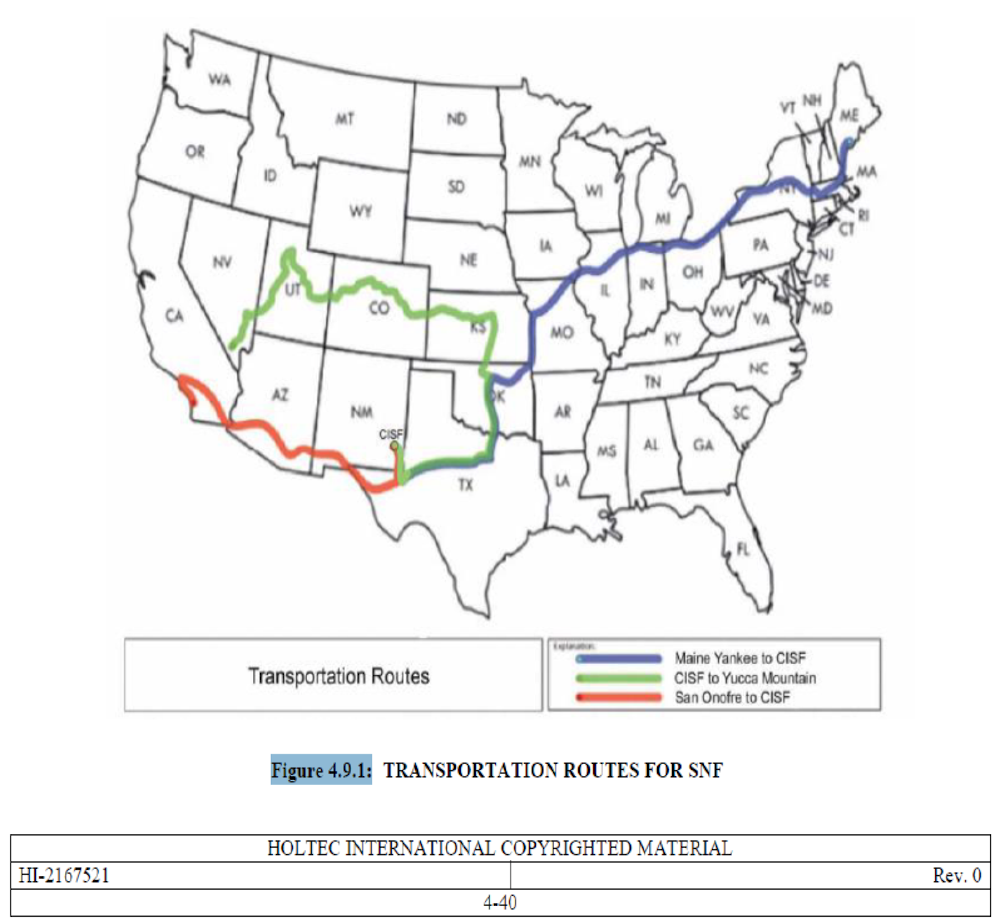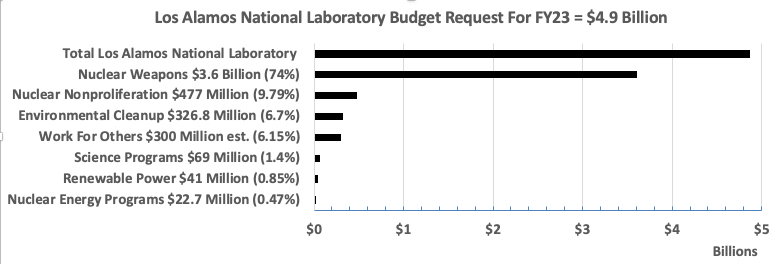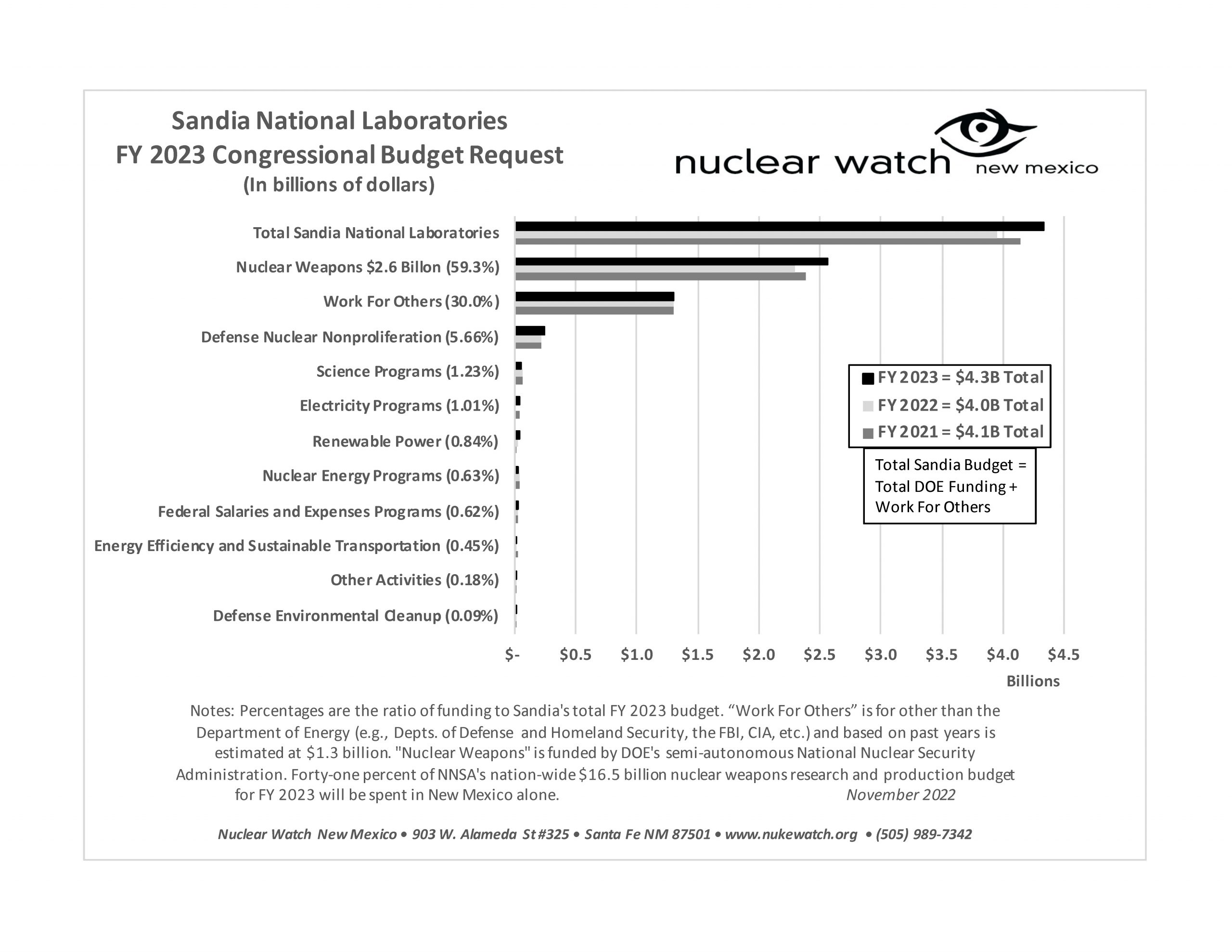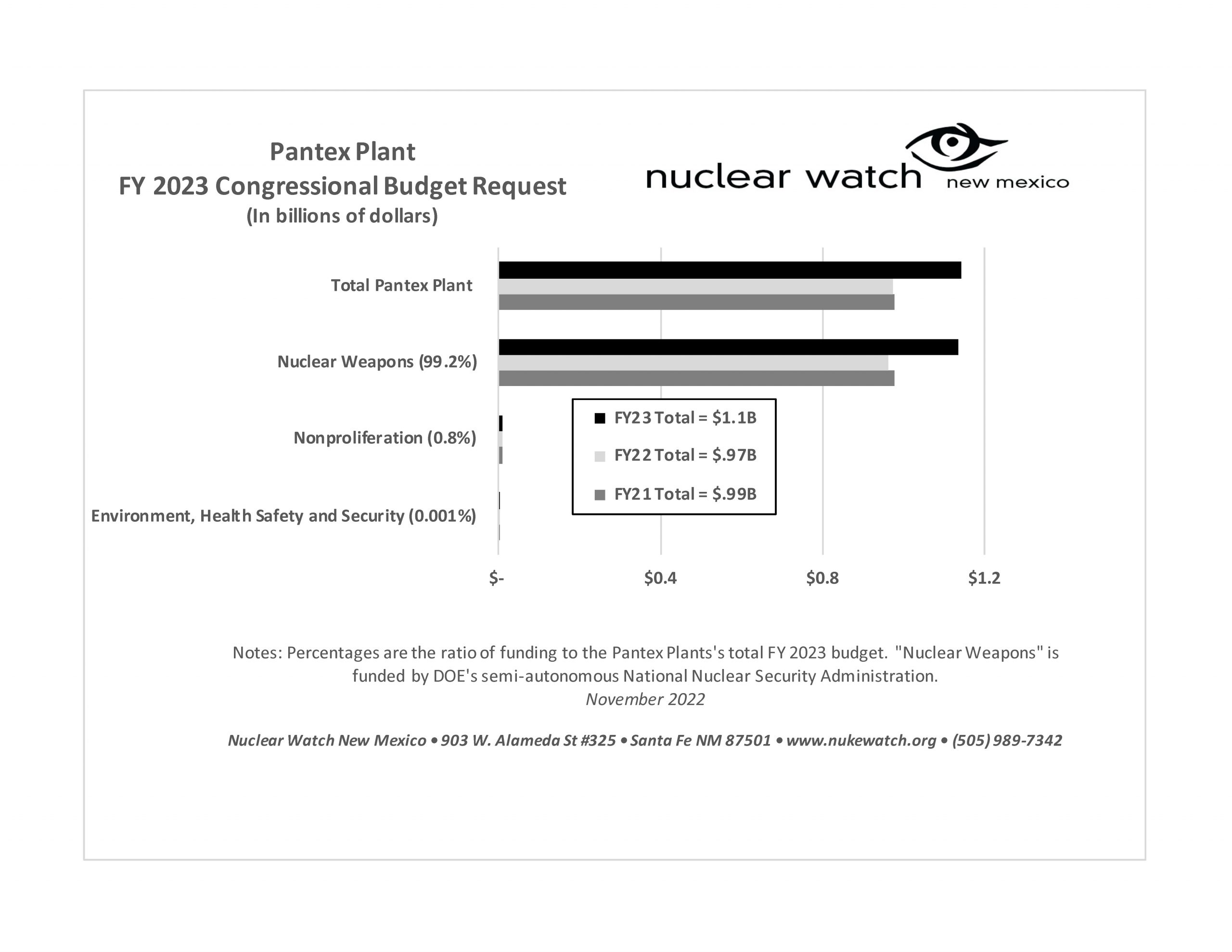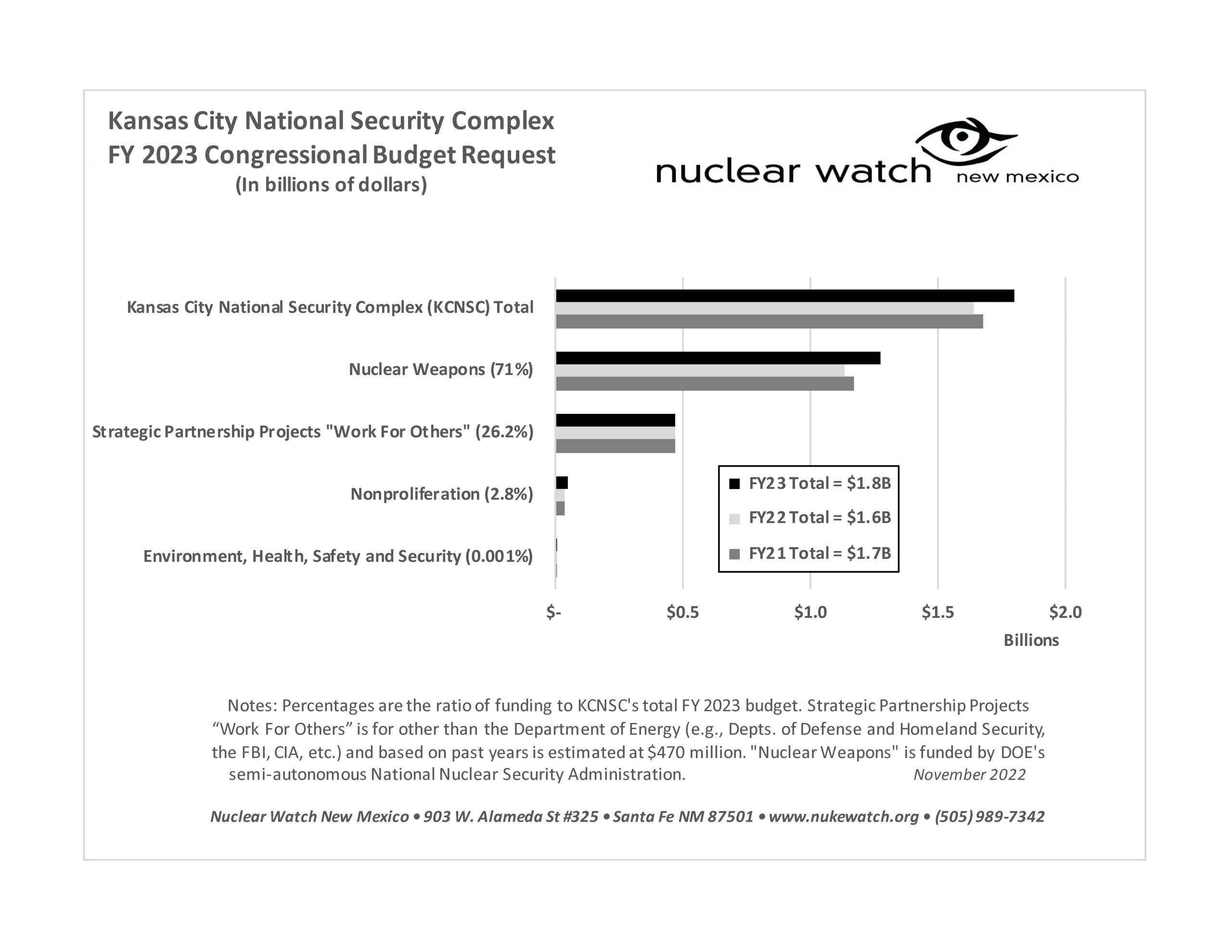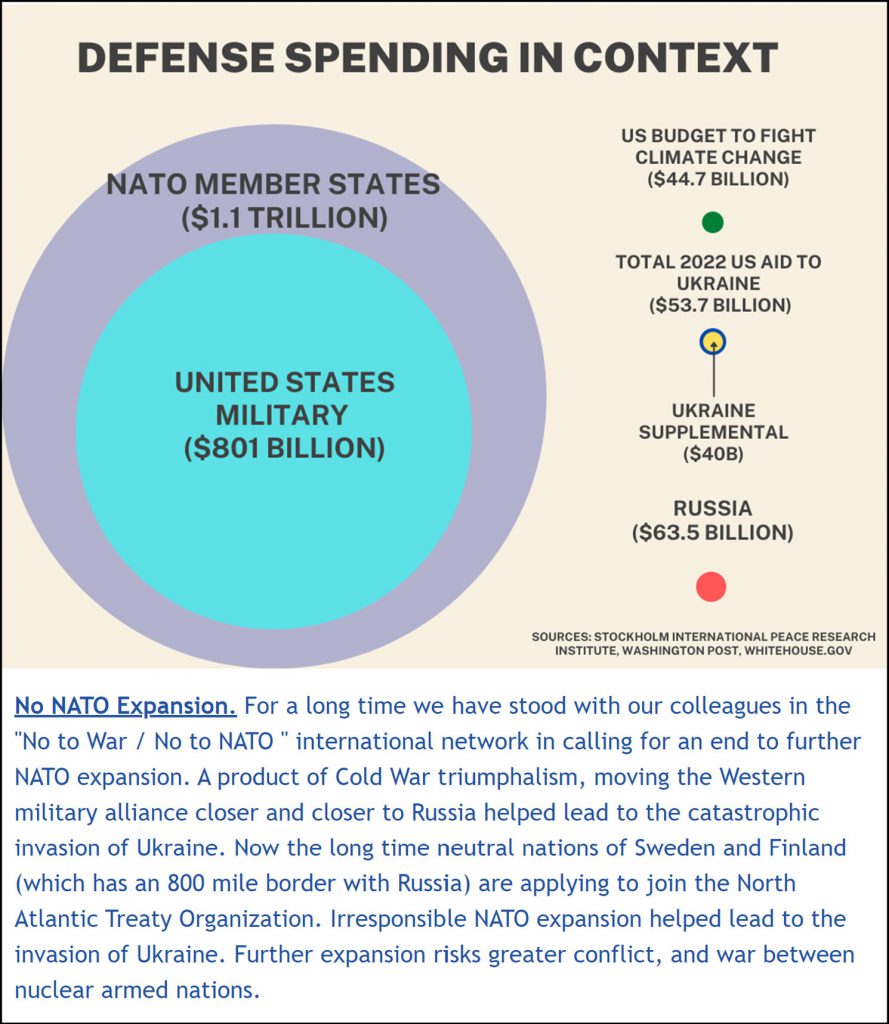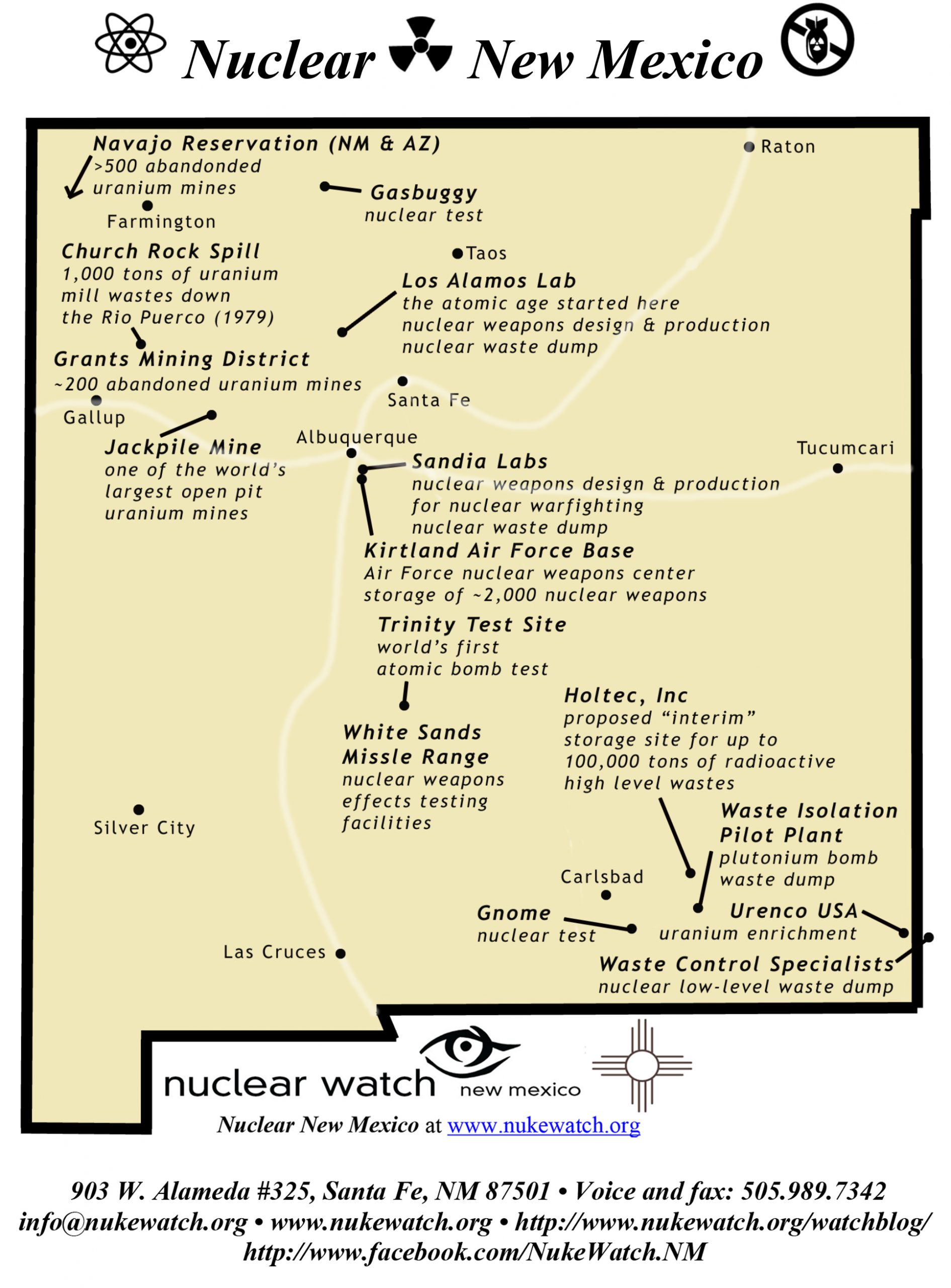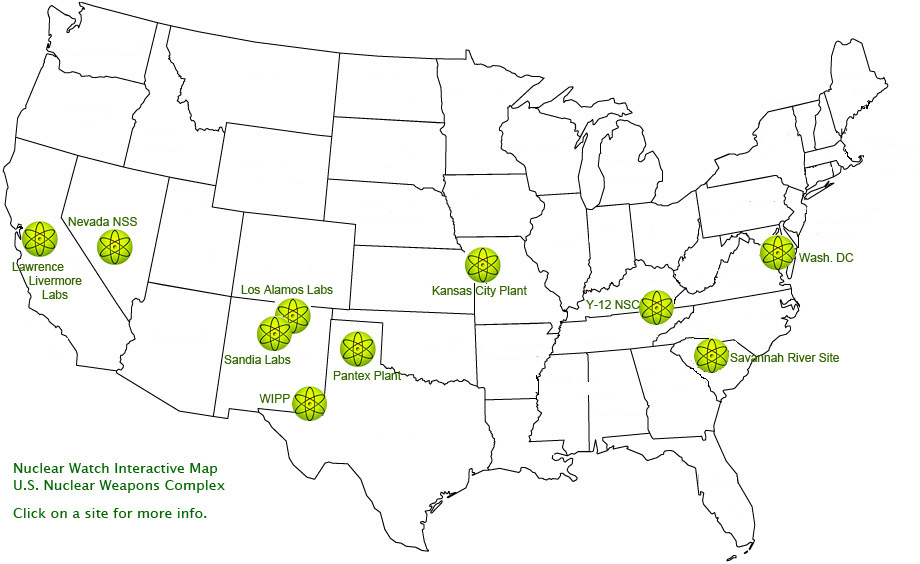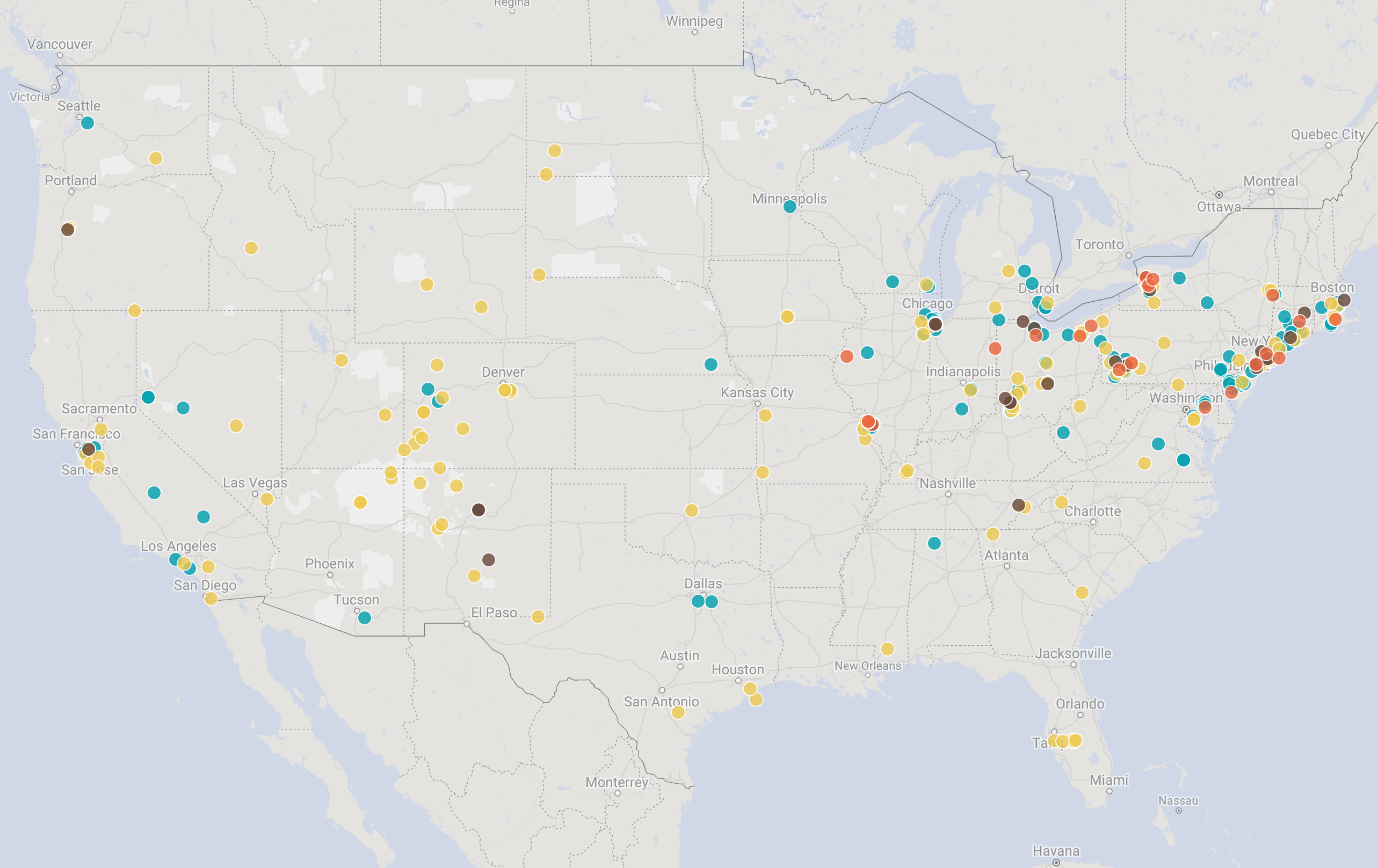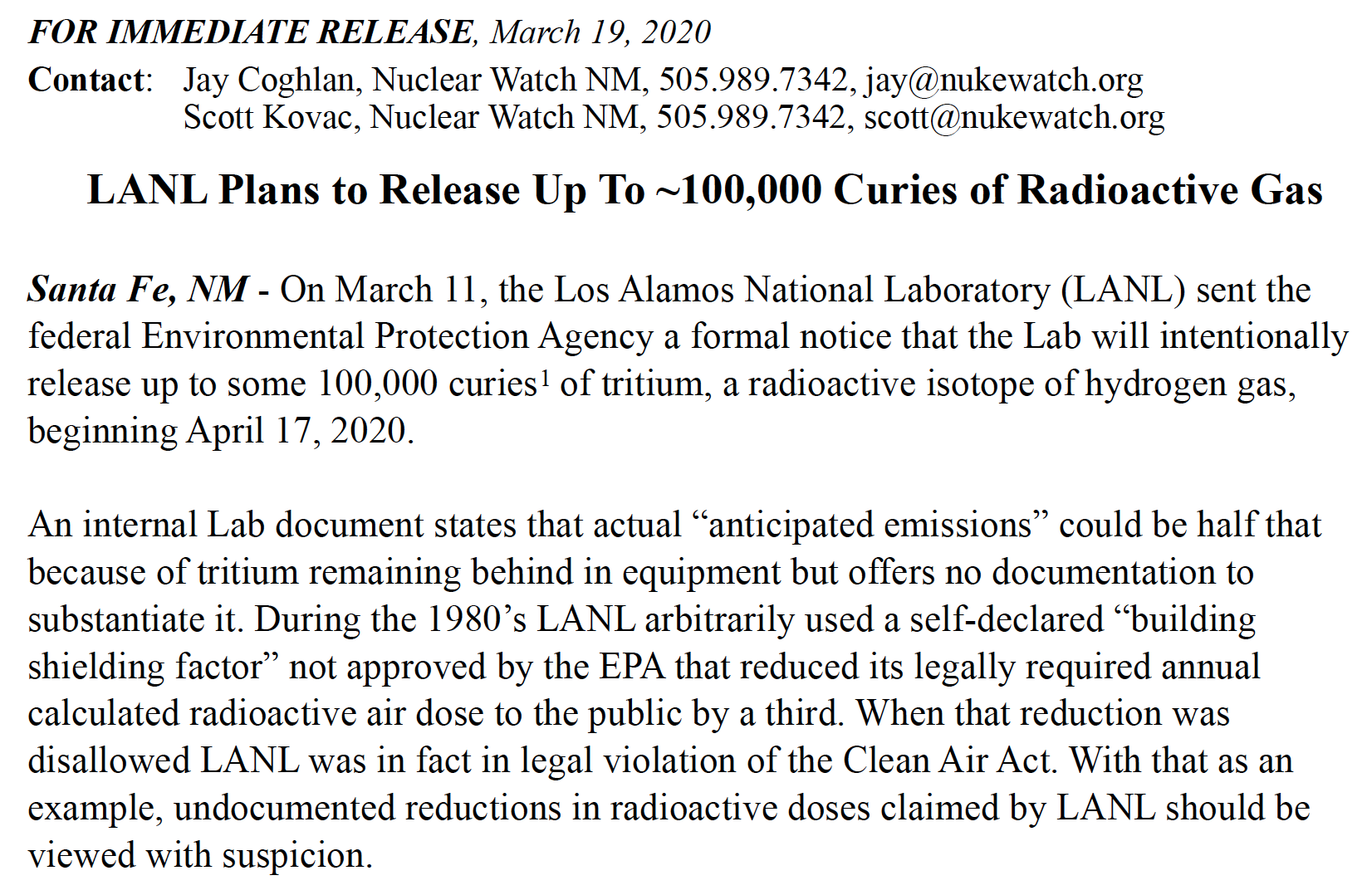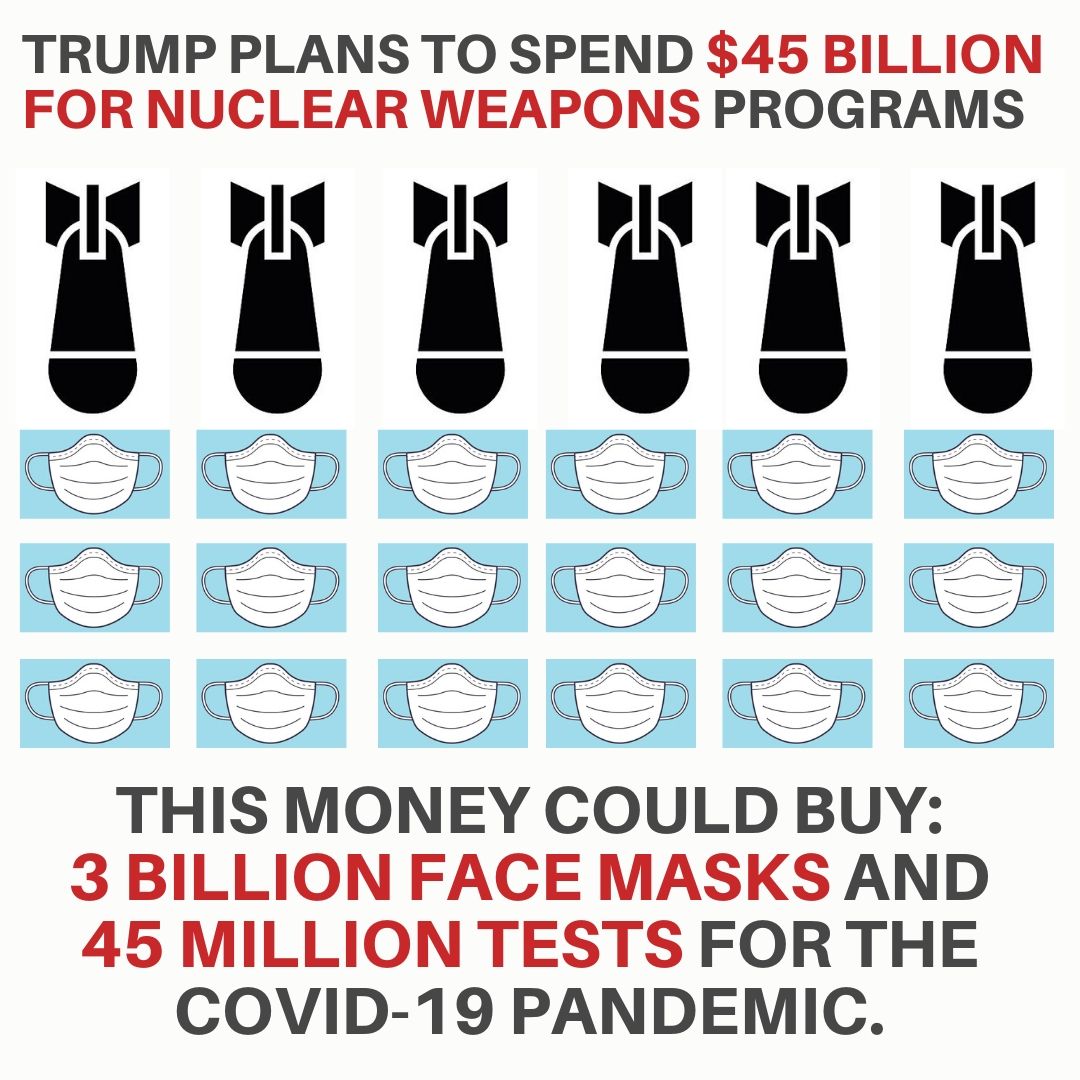QUOTE OF THE WEEK
Nothing Found
It seems we can’t find what you’re looking for. Perhaps searching can help.
LANL’s Central Mission: Los Alamos Lab officials have recently claimed that LANL has moved away from primarily nuclear weapons to “national security”, but what truly remains as the Labs central mission? Here’s the answer from one of its own documents:
LANL’s “Central Mission”- Presented at: RPI Nuclear Data 2011 Symposium for Criticality Safety and Reactor Applications (PDF) 4/27/11
Banner displaying “Nuclear Weapons Are Now Illegal” at the entrance in front of the Los Alamos National Lab to celebrate the Entry Into Force of the Nuclear Weapon Ban Treaty on January 22, 2021
Nothing Found
It seems we can’t find what you’re looking for. Perhaps searching can help.
Follow the Money!
Map of “Nuclear New Mexico”
Nuclear Watch Interactive Map – U.S. Nuclear Weapons Complex
In 1985, US President Ronald Reagan and and Russian President Mikhail Gorbachev declared that “a nuclear war cannot be won and must never be fought.”
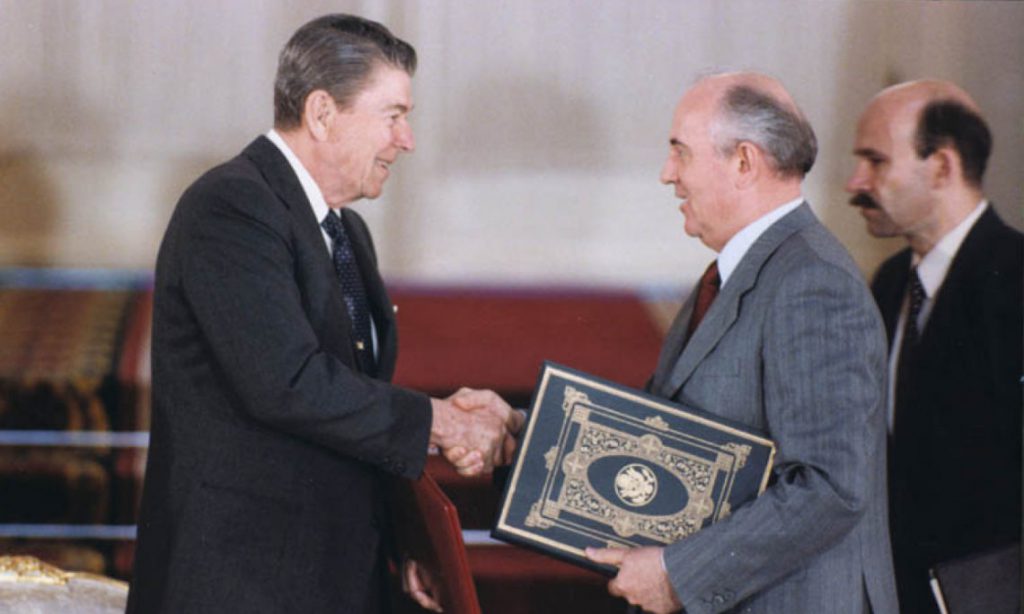
Waste Lands: America’s Forgotten Nuclear Legacy
The Wall St. Journal has compiled a searchable database of contaminated sites across the US. (view)
Related WSJ report: https://www.wsj.com
2022 BLOG POSTS
Nothing Found
It seems we can’t find what you’re looking for. Perhaps searching can help.
New & Updated
New study says LANL nuclear pit production could go higher
Jay Coghlan, executive director of Nuclear Watch New Mexico, said he doubted the lab has the “expertise and competence” to produce 80 plutonium pits, “but they’re going to eat up taxpayers’ money.” Coghlan said he’s also concerned about defense leaders refusing to use the thousands of pits stockpiled during the Cold War and instead favoring new, heavily modified pits. That raises the question of whether the Pentagon might resume nuclear testing on these untried cores instead of computer simulations.
BY: SCOTT WYLAND | santafenewmexican.com
Los Alamos National Laboratory should be able to produce 80 plutonium pits to meet surges in demand, not just the official goal of 30 pits a year, according to a proposed update to the lab’s last sitewide analysis.
Defense plans call for the lab to produce 30 pits — the grapefruit-sized explosive centers in nuclear warheads — in 2026 and the Savannah River Site to manufacture 50 in 2030.
ONE YEAR OF U.S. NUCLEAR WEAPONS SPENDING WOULD PROVIDE 300,000 ICU BEDS, 35,000 VENTILATORS AND SALARIES OF 75,000 DOCTORS
MATTHEW IMPELLI | newsweek.com
The amount of money spent in one year by the U.S. on nuclear weapons could instead provide 300,000 ICU (intensive care unit) beds, 35,000 ventilators and 75,000 doctors’ salaries, according to the International Campaign to Abolish Nuclear Weapons (ICAN)–a “coalition of non-government organizations promoting adherence to and implementation of the UN [United Nations} nuclear weapon ban treaty.”
In its recent report, the group stated that, according to armscontrol.org, the U.S. spent $35.1 billion on nuclear weapons in 2019. The costs are based on reported averages, but the study noted that the $35.1 billion in nuclear weapons spending would instead pay for “300,000 beds in intensive care units, 35,000 ventilators, and the salaries of 150,000 U.S. nurses and 75,000 U.S. doctors.”
E.P.A., Citing Coronavirus, Drastically Relaxes Rules for Polluters
“Environmental groups and former Obama administration officials described the policy as an unprecedented relaxation of rules for petrochemical plants and other major polluters.”

WASHINGTON — The Environmental Protection Agency on Thursday announced a sweeping relaxation of environmental rules in response to the coronavirus pandemic, allowing power plants, factories and other facilities to determine for themselves if they are able to meet legal requirements on reporting air and water pollution.
The move comes amid an influx of requests from businesses for a relaxation of regulations as they face layoffs, personnel restrictions and other problems related to the coronavirus outbreak.
Trump’s Environmental Rollbacks Find Opposition Within: Staff Scientists
“Federal scientists and lawyers, told to undo regulations that some have worked on for decades, have embedded data into technical documents that environmental lawyers are using to challenge the rollbacks.”
ARTICLE BY: CORAL DAVENPORT | nytimes.com
“WASHINGTON — President Trump has made rolling back environmental regulations a centerpiece of his administration, moving to erase Obama-era efforts ranging from landmark fuel efficiency standards and coal industry controls to more routine rules on paint solvents and industrial soot.
The Coronavirus and the Urgent Need to Redefine National Security
“In order to address serious domestic concerns [such as coronavirus], the United States must seek significant savings by reducing the Pentagon budget, ending endless wars, and returning to the arms control and disarmament arena.”
ARTICLE BY: MELVIN GOODMAN | counterpunch.org
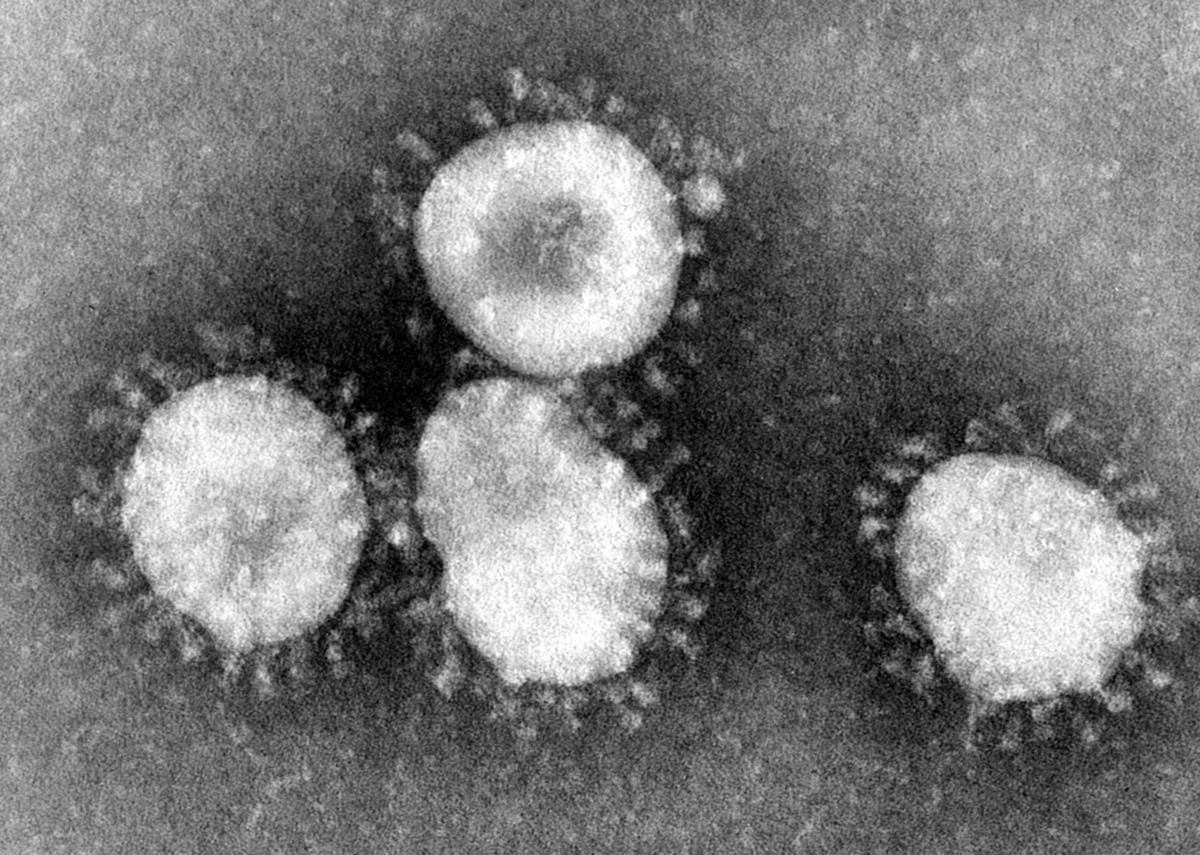
For far too long, the United States has been wastefully spending its precious budgetary resources on a nineteenth-century military strategy and a strategic arms policy that has brought no advantages to the American people. For the past three decades, our national security policies have been ineffectual and irrelevant to the genuine threats we face today. These threats do not emanate from Russia or China. Rather, they stem from an underfunded and highly vulnerable public health system, a cyber world that is out of control, and a crumbling infrastructure. In 2017, the American Society of Civil Engineers gave a grade of D-plus to the nation’s infrastructure, with the lowest grades going to roads, bridges, mass transit, and water management systems.
LANL set to release radioactive vapors
Los Alamos National Laboratory will release radioactive vapors into the atmosphere to ventilate several barrels of tritium-tainted waste generated during the Cold War. Jay Coghlan, executive director of Nuclear Watch New Mexico, said in the 1990s he won a lawsuit against the Energy Department for falsely claiming a building’s “shielding factor” kept radioactive emissions within federal limits.
“The undocumented assertion in the application that half of the tritium could remain behind in equipment should be viewed with suspicion,” Coghlan said.
ARTICLE BY: SCOTT WYLAND | santafenewmexican.com
The lab informed the U.S. Environmental Protection Agency earlier this month that it would ventilate four waste containers, beginning April 17, to relieve the built-up, radioactive hydrogen in the barrels’ headspace to prevent them from rupturing while they’re being handled. The EPA approved the application for the radioactive release last year.
Groups Request DOE Publish “Notice” of Release of Plutonium Bomb Document in Federal Register
“Request to Publish Notice of Draft Supplement Analysis in the Federal Register, DOE/EIS-0380-SA-06: Draft Supplement Analysis”
Public interest groups working for US DOE to fully comply with the National Environmental Policy Act (NEPA) in its unjustified plans to produce more plutonium “pits” for new and refurbished nuclear weapons have written to DOE concerning plans for expanded pit production at the Los Alamos National Lab in New Mexico. The lawyer for SRS Watch, Nuclear Watch New Mexico (Santa Fee, NM) and Tri-Valley CARES (Livermore, CA) wrote to DOE’s National Nuclear Security Administration (NNSA) on March 20, 2020, requesting that NNSA publish in the Federal Register a notice that a document on pit production was released on March 10, 2020 and, further, that it be opened for a 45-day comment period from the date of publication in the Federal Register.
The group letter is posted here: Request for Publication of Notice of Draft SA in Federal Register March 20 2020
Undisclosed delays plague atomic programs, cost billions to fix
“The Trump administration wants $3.1 billion more this year than last for the Energy Department’s nuclear weapons budget, but internal government documents show the raise is devoted substantially to covering previously undisclosed cost overruns and avoiding years of new delays in the majority of U.S. atomic weapons programs.”
ARTICLE BY: JOHN M. DONNELLY | rollcall.com

The new NNSA budget request is the latest example of the agency’s long-running problems
The Trump administration wants $3.1 billion more this year than last for the Energy Department’s nuclear weapons budget, but internal government documents show the raise is devoted substantially to covering previously undisclosed cost overruns and avoiding years of new delays in the majority of U.S. atomic weapons programs.
The administration has sold the 25 percent budget boost for the National Nuclear Security Administration only in broad terms as necessary to maintain America’s nuclear deterrent. However, the additional funds are needed not so much to advance capabilities as merely to keep troubled programs from falling further behind, according to the “official use only” correspondence obtained by CQ Roll Call.
LANL Plans to Release Up To ~100,000 Curies of Radioactive Gas
Santa Fe, NM – On March 11, the Los Alamos National Laboratory (LANL) sent the federal Environmental Protection Agency a formal notice that the Lab will intentionally release up to some 100,000 curies of tritium, a radioactive isotope of hydrogen gas, beginning April 17, 2020.
An internal Lab document states that actual “anticipated emissions” could be half that because of tritium remaining behind in equipment but offers no documentation to substantiate it. During the 1980’s LANL arbitrarily used a self-declared “building shielding factor” not approved by the EPA that reduced its legally required annual calculated radioactive air dose to the public by a third. When that reduction was disallowed LANL was in fact in legal violation of the Clean Air Act. With that as an example, undocumented reductions in radioactive doses claimed by LANL should be viewed with suspicion.
More Information on Tritium’s Significant Hazards
Routine Radioactive Releases from U.S. Nuclear Power Plants. An update to our comprehensive list and map of all operating U.S. reactors and where they release radioactivity into the air and water. Every nuclear power reactor dumps radioactive water, scatters radioactive particles, and disperses radioactive gases as part of its routine, everyday operation. It doesn’t take an accident. Federal regulations permit these radioactive releases. Any exposure to radiation increases the risk of damage to tissues, cells, DNA, and other vital molecules, potentially causing genetic mutations, cancers, leukemias, birth defects, and reproductive, cardiovascular, endocribe, and immune system disorders.
The pamphlet lists all reactors operating at the October 2015 press time. For an up to date track of reactors as they close, please visit our Reactors Are Closing page
[This pamphlet is broader than just tritium, but tritium plays a significant part. See especially the discussion of how hazardous even a couple of curies of hazardous radioactivity, badly handled, can be.]
Reports
Leak First, Fix Later: Uncontrolled and Unmonitored Radioactive Releases from Nuclear Power Plants
UPDATED!
Leak First, Fix Later: Uncontrolled and Unmonitored Radioactive Releases from Nuclear Power Plants. May 2015. Newly revised and updated from the original, Leak First is a Beyond Nuclear report on the persistent and ongoing leaking of radioactive effluent into ground and surface water from uninspected and unmaintained buried piping under every nuclear power plant.
UPDATED!
Executive Summary. May 2015.
Note: New leaks occur often and at multiple nuclear reactor sites. Watch this page for updates on new leaks and spills.
LANL waste is unearthed at housing site
A utility crew found hazardous waste buried on land the U.S. Energy Department had transferred to Los Alamos County, stalling work on an affordable housing project.
ARTICLE BY: SCOTT WYLAND | santafenewmexican.com
The discovery of low-level radioactive waste 7 to 12 feet in the ground off DP Road last month prompted the state Environment Department to write a letter that ordered the agency to supply more information about the waste, how it got there and how the agency planned to avoid future incidents.
The state agency is “extremely concerned” about the contamination unearthed on a former Los Alamos National Laboratory site and “the potential threat to human health and the environment,” wrote Kevin Pierard, the department’s Hazardous Waste Bureau chief, in a Feb. 28 letter.
Pierard demanded Energy Department and lab officials submit data on the site and the sources of contamination, as well as tests and investigations that were conducted.
“We are currently investigating and characterizing the waste located at the site to determine the extent of the contamination,” Energy Department managers wrote in response.
The waste was placed in three drums and moved to another site for further analysis, the Energy Department said. Crews have fenced off the construction site, covered it with tarp and posted signs to keep people out, the letter said.
What is real national security? Comprehensive public health or more nuclear weapons?
Public Health as a National Security Concern
“Different perspectives on what “security” means compete for attention, and the literature that brings public health and national security together forces those in public health to contemplate these different perspectives and how they relate to the public health mission of protecting population health.” — Fidler, David P., “Public Health and National Security in the Global Age: Infectious Diseases, Bioterrorism, and Realpolitik”
ACTION ALERTS
Nothing Found
It seems we can’t find what you’re looking for. Perhaps searching can help.
Nothing Found
It seems we can’t find what you’re looking for. Perhaps searching can help.
Interfaith Panel Discussion on Nuclear Disarmament - August 9
Nothing Found
It seems we can’t find what you’re looking for. Perhaps searching can help.
New Nuclear Media
Nothing Found
It seems we can’t find what you’re looking for. Perhaps searching can help.

